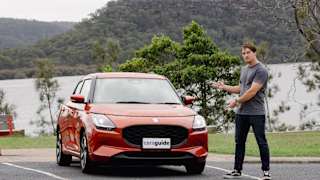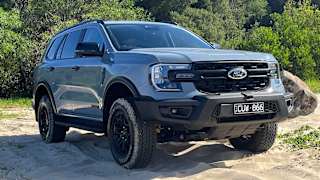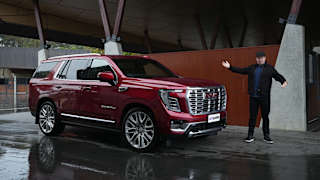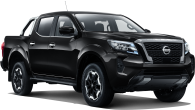Isuzu’s line-up of D-Max utes is already rather extensive but the car maker has further bolstered the range with some new variants, one of which is the LS-U+.
This ute slots in between the top-shelf X-Terrain and the mid-spec LS-U and its aimed at those who tow – or who want to tow – as part of their work-and-play lifestyle and, as such, this variant is equipped as standard with a tow bar receiver, and an extra 100kg of GVM (gross vehicle mass) over the 21MY D-Max LS-U.
It offers a few other features – including premium black leather-accented upholstery and interior trims, and heated front seats – that Isuzu is hoping will lure even more buyers to its range.
So, is this new D-Max variant worth your attention? We took it on a long-distance test on sealed surfaces, beach sand and through mud to scrutinise this new D-Max. Read on.
Isuzu D-MAX 2022: LS-U+ (4X4)
| Engine Type | Diesel Turbo 4, 3.0L |
|---|---|
| Fuel Type | Diesel |
| Fuel Efficiency | 7.7L/100km (combined) |
| Seating | 5 |
| Price From | $52,910 - $60,830 |
| Safety Rating |
|
Does it represent good value for the price? What features does it come with?
The LS-U+ crew cab 4x4 has a manufacturer suggested retail price (MSRP) of $63,500, which does not include on-road costs.
With Mercury Silver metallic paint ($650) and on road costs ($5481) taken care of, then this variant’s recommended drive away price climbs to $69,631.
However, our test vehicle was fitted with a tow bar wiring harness (12 Pin Flat, $359), electronic brake controller ($820), electric roller tonneau cover ($3792.80) and stamp duty ($248.59) had been sorted out, so its total driveaway price as tested ends up as $74,851.39.
.jpg)
Standard features in this new variant, setting it apart from the LS-U, include black leather-accented upholstery and interior trims, heated front seats, a power-adjustable driver’s seat (with eight-way electric adjustment and electric lumbar support), dual vanity mirror lights, auto-dimming rear view mirror, heated door mirrors, a Lane Support System (LSS) Switch (which is aimed at making it easier to switch through driver-assist aids), a GCM (gross combined mass) of 6000kg and a factory-fitted tow bar receiver and tub liner.
Otherwise it comes equipped with a 9.0-inch touchscreen multimedia display with sat-nav, Android Auto and wireless Apple CarPlay, smart keyless entry, chrome door handles, tailgate handle, handbrake button, side mirrors and front grille, LED daytime running lights (DRL), with auto-levelling and automatic high beam control, rear parking sensors, under rail tub liner, and 18-inch machined-face alloy wheels with 265/60R18 Bridgestone 684II HT.
.jpg)
Available paint finishes are Mineral White, Basalt Black mica, Cobalt Blue mica, Mercury Silver metallic, Obsidian Grey metallic, Marble White pearl, and Magnetic Red mica.
Is there anything interesting about its design?
In terms of appearance, inside and out, the LS-U+ doesn’t differ much from the LS-U except for those aforementioned touch-ups (i.e. black leather-accented upholstery and interior trims etc).
.jpg)
I reckon the D-Max looks pretty good, but you can make up your own mind.
This variant has a powered roller tub cover, which looks decent and works well.

What are the key stats for the engine and transmission?
The LS-U+ has the line-up’s 3.0-litre four-cylinder turbo-diesel engine – producing 140kW at 3600rpm and 450Nm at 1600-2600rpm.
That engine is matched to a six-speed automatic transmission and the combination is a solid, proven teaming – working well through most driving scenarios and conditions.
.jpg)
This is not the torquiest 4WD ute engine on the market, but it’s simply so unstressed in its all-round delivery that it’s easy for the D-Max to just keep trucking along without a care in the world.
The D-Max has a part-time 4WD system. It has a dual-range transfer case (with high-and low-range 4WD), an off-road traction control system and a rear diff-lock. The driver is able to shift from 2H (two-wheel drive, high range) to 4H (4WD high range) while on the move, and up to speeds of 100km/h, The diff-lock may only be engaged when the vehicle is in 4L (4WD low range).
How practical is the space inside?
The LS-U+ has no significant changes over the LS-U, in terms of practicality, other than the electric roller-top tonneau cover over the tub.
The cabin’s interior is a nice, basic, but well-dressed space; a pleasant blend of functionality with an understated not-quite-premium feel to everything.
_0.jpg)
Upfront is comfortable; nicely appointed with leather-accented upholstery and soft-touch surfaces and well equipped with an easy-to-use 9.0-inch multimedia touch screen, USB charge points, a plethora of storage spaces and everything is simple enough to access and make use of.
The seats are supportive and comfortable and well-suited to long days of travel.
.jpg)
The back row is a comfortable space with sufficient room – head, legs, and knees – and there are plenty of storage spaces, including cup holders in the fold-down centre arm-rest, map pockets in the seat-backs, and bottle holders in the doors.
There are air vents and a USB charging point in the back of the centre console, and a pop-out cargo hook in the back of the front passenger seat on which to hang a shopping bag.
What's it like as a daily driver?
A multi-day long-distance test offers the driver and passengers the opportunity to get much more of an immersive experience in a vehicle than a seven-day test could ever yield.
And so was the case with this two-week trip along the east coast of Australia that totalled more than 3500km when it eventually drew to a close.
So much time spent in the D-Max merely cemented many of the positives I’d recognised and acknowledged in previous much shorter tests.
Long days on the road (some of those more than eight hours and 700km a pop) weren’t as punishing as you might imagine because the D-Max offers very agreeable levels of comfort and refinement – for a ute.
The LS-U+ has a listed kerb weight of 2112kg (that’s with 76L of fuel) and a turning circle of 12.5m. It measures 5270mm long (with a 3125mm wheelbase), 1870mm wide and 1790mm high, so it occupies not an insignificant amount of space and yet it always feels very manoeuvrable.
.jpg)
Steering is well-weighted, but retains a keen balance about it on the bitumen, with minimal ‘play’ in the steering wheel itself in evidence.
Throttle response is impressive, with smooth acceleration from a standing start and there’s plenty of punch available when push comes to shove on the open road and you need to smoothly overtake another vehicle, all the while maintaining absolute control.
The engine and transmission, always a standout in the D-Max range, continue to give this ute plenty of appeal as a daily driver and touring platform. Sure, engine noise can creep into the raucous zone when you apply heavy throttle, but that’s easy to forgive when the D-Max is otherwise such a relaxed general-duties vehicle.
In terms of NVH (noise, vibration and harshness) levels, beyond that diesel clatter in the background and some wind-rush around the big wing mirrors, most potential in-cabin intrusions are kept to a minimum.
Ride and handling are well-controlled, with the suspension set-up – wishbones and coil springs at the front, three-leaf springs at the rear – working nicely to soften the impact of most surface imperfections.
.jpg)
The D-Max remains more than a little bit truck-like, but I don’t mind the fact that it’s not quite as refined as other rivals claim to be.
Niggles? All doors in the stationery vehicle lock automatically when all are closed, even momentarily. And they do so with a loud beep every time. To unlock the doors, you have to rummage in your pocket, find the keys and unlock the cab. Yep, first-world problems, but the wrong side of annoying when you’re packing/unpacking and someone closes a door – and the open-close process has to start all over again. There’s likely a way to disable this function – including the beeps – or, at least, delay the auto-locking action but I didn’t take the time to check the owner’s manual and sort it out.
The adaptive cruise control is generally very cluey and maintains your selected speed as required but at times it can get a bit out of sorts, especially on long gradual hills, going uncomfortably faster or slower than your actual set speed.
What's it like for touring?
We’ve tested a lot of 4x4 D-Max variants over the years and they’ve all consistently impressed in off-road scenarios. This one was no different.
We drove the LS-U+ along muddy tracks and through mud holes on a Queensland sugar-cane farm as well as took it on the beach for a fair few kays of sand driving. As expected the Isuzu ute fared very well indeed.
The engine and transmission, that work so well together on-road, are really good off-road when it’s time for low-speed, low-range 4WDing.
The low-revving engine is not the torquiest one around, but it never seems stressed, in high- or low-range over a variety of terrain, and things just tick along nicely. There is ample accessible torque across a wide rev range, and that’s crucial when you're off-roading.
A ute’s suspension set-up is always a contentious issue because it's never going to be as well sorted as a wagon or a strictly road-going vehicle. Having said that, the D-Max’s suspension does a good job of keeping everything controlled on-road and settled when a bitumen road becomes a gravel or dirt track.
.jpg)
And this ute impresses on other surfaces as well.
With its tyre pressures dropped to 20 psi (pounds per square inch) the D-Max cruised along the hard-packed sand of a beach at low tide without any strife.
Low-range gearing is sound, throttle response is good – with a pedal that’s not too sensitive when you’re bouncing around off-road – and the recalibrated traction control, while not quite as dialled-in and finessed as some of its rivals’ systems, is effective.
The D-Max’s electronic rear diff lock can be engaged at speeds up to 8km/h and only when you're in four-wheel drive low-range (4L). It will disengage when you hit 30km/h or more. Note: when you engage the diff lock, off-road traction control is disengaged. The rear diff lock is a very handy addition and one that’ll help to keep you moving along off-road on traction-compromised terrain and give you more peace of mind on the tracks.
Hill descent control is impressive, holding our test vehicle to a controlled 3-4km/h while traversing a few short but steep declines.
Niggles? As always I have an issue with showroom-standard tyres – something of an unnecessary evil in vehicles that are essentially trying to achieve two very different sets of goals: be quiet and comfortable on-road, and be effective off-road.
.jpg)
Vehicle manufacturers understandably put road-biased rubber on their lifestyle vehicles because those tyres yield a quiet, comfortable ride on-road, but they’re not suited to 4WDing. It’s an easy enough problem to solve: buy a set of decent all-terrain tyres to replace the road rubber.
The LS-U+ has a claimed 240mm of ground clearance, a wading depth of 800mm and approach, departure and ramp-over angles of 30.5 degrees, 19.0 degrees, and 23.8 degrees, respectively.
But it feels prone to rubbing its underbody and/or side steps on the dirt or on more substantial protrusions in the terrain (rocks, tree roots etc). Thankfully, the D-Max has factory-fitted 1.5mm-thick steel and 5mm-thick poly-composite underbody protection over powertrain components.
This ute’s low-riding sensation can be somewhat negated with slower, more considered driving, but it can also be swiftly resolved with an aftermarket suspension lift if you plan to use your D-Max as an off-road tourer for destinations beyond the well-beaten tracks.
_0.jpg)
If you’re keen to use this D-Max as a touring platform for your off-road adventures, you’ll be interested in its load-carrying capacities, so here they are: payload is listed as 935kg, unbraked towing capacity is 750kg and braked towing capacity is 3500kg.
The LS-U+ comes standard with a tow bar receiver. You can also tailor your towing kit to suit as Isuzu Ute Genuine Accessories include an optional 7- or 12-pin plug, electronic brake controller, tow tongue insert with 50mm ball and weight-distribution hitch.
Gross vehicle mass (GVM) is 3100kg, and gross combined mass (GCM) is up 50 kilograms over previous variants, from 5950kg to 6000kg. Every little bit helps when it comes to packing for off-road trips and that 50kg increase means you are given a little bit more leeway with how much you can take away with you, onboard and towing (GCM).
The LS-U+ tub is 1495mm long (at rail height), a listed 1530mm wide (1122mm wide between wheel arches) and the load-space is 490mm deep.
It has a sturdy tub liner, built-in tie-down points and an electric roller-top cover over its tub.
.jpg)
This tonneau cover set-up keeps whatever you have stored in the tub out of the elements and away from prying eyes.
We’ve used manual versions of this roller cover in the past and been less than impressed with their operation, especially once dirt and debris gets into the roller mechanism and prevents it working smoothly. Not so this time. There’s a more robust brush atop the roller cover and that clears away any dirt and debris from the cover’s surface as it’s retracted into its drum. And the operation of the roller cover itself is a simple and smooth one: just a push on the key fob to open or close. Impressive.
The roller-cover drum still takes up some packing space in the tub, but it’s not as bulky as it once was in past utes.
Also, tonneau covers limit the tub’s packing flexibility. If you have so much gear you have to leave the cover open, even partially, and pack above the heigh of the tonneau, you only have two tie-down points with which to secure the load – not ideal.
How much fuel does it consume?
Official fuel consumption is listed as 8.0L/100km.
On our test, which included a lot of driving on sealed surfaces and high-range 4WDing on firm sand and some low-range 4WDing through softer sand and mud, we recorded an average fuel consumption of 7.9L/100km.
It has a 76-litre fuel tank so, with that sort of fuel-consumption figure, you can reasonably expect a driving range of approximately 910km from a full tank, but that’s factoring in a safe-distance buffer of 50km.
Warranty & Safety Rating
What safety equipment is fitted? What safety rating?
The D-Max range has a five-star ANCAP rating from testing in 2020.
It has eight airbags (including a knee and centre airbag) and every D-MAX has Isuzu’s Intelligent Driver Assistance System (IDAS), which includes such driver-assist tech as AEB, adaptive cruise control, Lane Keep Assist, Lane Departure Prevention, Traffic Sign Recognition, and a reversing camera with rear cross traffic alert.
The rear seat has three child-seat anchorage points and one ISOFIX point each on the outboard seats.
What does it cost to own? What warranty is offered?
The D-Max has a six-year/150,000km warranty and up to seven years of roadside assistance.
That warranty is okay in terms of years, but unlimited kms would be a welcome sweetener.
Service intervals are scheduled for every 12 months or 15,000km, whichever occurs soonest.
Capped Price Servicing covers the first seven scheduled services (i.e. the first seven years of the new vehicle’s ‘life’). The cost per service is $409 at 15,000km, $429 at 30,000km, $629 at 45,000km, $529 at 60,000km, $319 at 75,000km, $769 at 90,000km, and $429 at 105,000km – for a total cost of $3513, according to Isuzu.
Servicing costs are getting steep and, in an increasingly competitive dual-cab ute market, potential buyers should closely scrutinise those.
Verdict
The Isuzu D-Max is an impressive all-rounder in most guises and the LS-U+ spec simply adds a ready-made tow-friendly set-up to a vehicle that’s already well-suited to the outdoors lifestyle.
This ute is comfortable on-road – nice to drive and refined (for a ute!) – and it’s a very capable 4WD. It’s packed with (mostly) well-behaved and quietly effective driver-assist tech and – bonus – its fuel consumption is on the right side of impressive.
If you’re in the market for a tow vehicle and you’re keen for a D-Max, then you could do a lot worse than consider the LS-U+.
Pricing Guides








.jpg)







.jpg)
.jpg)







.jpg)
.jpg)

.jpg)


.jpg)

